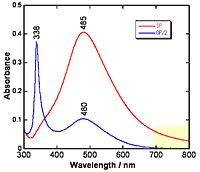Vis-MAIRS: Spectroscopic analysis of plasmon-polariton propagation in a thin film
Multiple-angle incidence resolution spectrometry (MAIRS) coupled with infrared (IR) spectrometry is a technique originally developed to analyze molecular orientation in an organic thin film. It involves a concept of 'virtual light', in which the electric-field oscillation is parallel to the traveling direction of the light. To extend MAIRS to visible light, however, researchers must overcome the matter of low refractive index substrates in the region. Now, Takeshi Hasegawa and colleagues at Tokyo Institute of Technology have solved this problem in both theoretical and experimental approaches.
The researchers first studied the low refractive index problem by way of a 'regression equation' followed by the authentic Maxwell equations. This suggested that measurements of p-polarization in the light could overcome the problem. In addition, the researchers searched for optimal experimental conditions for the new technique. Thanks to this work, they can report the world's first MAIRS spectra of a silver thin film (5 nanometres thick) in a visible region. The spectra clearly revealed that plasmon-polaritons—electron oscillations coupled to photons—propagate a long distance through the film in the in-plane direction, but not in the out-of-plane direction.
In conclusion, the Vis-MAIRS technique has opened the way to studying the structure and characteristics of metal nanoparticle films from a spectroscopic approach.
T. Hasegawa , Y. Itoh, and A. Kasuya
, Y. Itoh, and A. Kasuya
Analytical Chemistry 80 (14), 5630-5634 (2008)
Department of Chemistry

Vis-MAIRS spectra of a 5-nanometre-thick silver evaporated film on glass, showing the absorption of visible light in the in-plane (red) and out-of-plane (blue) directions.
. Any information published on this site will be valid in relation to Science Tokyo.



